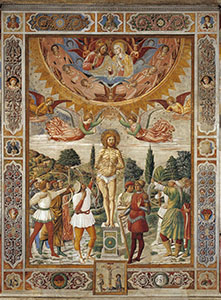
Saint Sebastian, Collegiate Church, San Gimignano.
Following the terrible plague that struck many towns, including San Gimignano, in the 1460s, the Town Council decided on various occasions in 1463 and 1464 to commission an ex-voto image in the chapel dedicated to Saints Fabian and Sebastian, which had been erected on the counter-façade of the Collegiate Church of Santa Maria Assunta after the previous epidemic of 1348.
The task was only entrusted to Benozzo in 1465, after he had already painted another votive fresco to Saint Sebastian for the Church of Saint Augustine. The artist completed this new work on 18th January 1466, two days before the feast day of that Saint who, together with Saint Roch, was traditionally considered a protector against the plague.
In this fresco, Augustine is depicted in the traditional iconographic manner, clad only in a loincloth and pierced by a throng of arrows, symbolising the plague, shot at him by bold archers. As in the church of Saint Augustine, Benozzo portrays Sebastian on a marble pedestal, this time with a manifest desire to liken the saint to the figure of Jesus. Indeed, his posture is similar to that of Christ flagellated and suffering for the salvation of mankind. Portrayed in the upper register are Jesus and the Virgin Mary, respectively in the acts of blessing and praying, surrounded by a host of cherubim and seraphim. Immediately above the figure of Saint Sebastian are two angels bestowing a crown upon him.
This image, a continuation of the fresco that Benozzo had previously painted for the church of Saint Augustine, also dedicated to Saint Sebastian, bears witness to the strength of the devotion of both the lay and religious communities to the martyr, who was called upon to protect the town from the terrifying disease.
The work is signed and dated in the margin of the lower decorative fascia.
Serena Nocentini